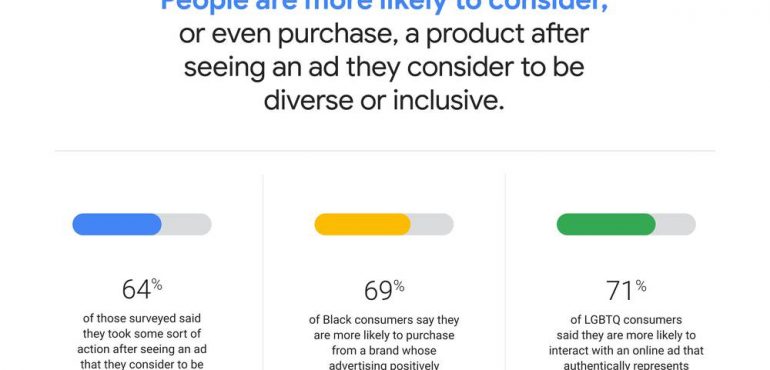Inclusive Ads are Affecting Consumer Behavior
The Female Quotient partnered with Google and Ipsos this past summer to survey nearly 3,000 U.S. consumers of various backgrounds to understand perceptions surrounding diversity and inclusion in advertising. My team and I asked people about the factors they think are important for a brand’s ad campaign to be considered diverse or inclusive. Specifically, we surveyed respondents about 12 categories: gender identity, age, body type, race/ethnicity, culture, sexual orientation, skin tone, language, religious/spiritual affiliation, physical ability, socio-economic status, and overall appearance.
We learned that people are more likely to consider, or even purchase, a product after seeing an ad they think is diverse or inclusive (in reference to the 12 categories discussed in this study). In fact, 64% of those surveyed said they took some sort of action after seeing an ad that they considered to be diverse or inclusive.1 This percentage is higher among specific consumer groups including Latinx+ (85%), Black (79%), Asian/Pacific Islander (79%), LGBTQ (85%), millennial (77%), and teen (76%) consumers.
Consumers expect brands to be inclusive and reflect the reality of their lives in advertising. Of the various groups surveyed, LGBTQ and Black respondents expressed the strongest preference for diverse and inclusive ads. For example, 69% of Black consumers say they are more likely to purchase from a brand whose advertising positively reflects their race/ethnicity.
If you seek to enter diverse markets, your organization must become the market you seek.
“If you seek to enter diverse markets, your organization must become the market you seek,” said Johnson. “The more distance there is culturally between your team and the market, the less ability you will have to execute. We all fall into particular biases. That’s why you need to have culturally competent people in the room who have the power to affect decisions. By bringing in the talents of those who have traditionally been overlooked, you unlock true creative expression — and build an organization able to check its biases.”
At the Female Quotient, we’ve seen that brands can “do good” and do well at the same time if they practice what they preach with an authentic voice and consistency. A brand’s promise should be aligned with the brand’s culture. People can sense when a brand is merely saying what it needs to say versus truly walking the walk. Ultimately, brands must reinforce their value proposition from the inside out if they truly want to drive change.
